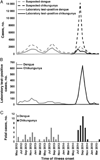Surveillance for Chikungunya and Dengue During the First Year of Chikungunya Virus Circulation in Puerto Rico
- PMID: 27920177
- PMCID: PMC5175481
- DOI: 10.1093/infdis/jiw245
Surveillance for Chikungunya and Dengue During the First Year of Chikungunya Virus Circulation in Puerto Rico
Abstract
After chikungunya virus (CHIKV) transmission was detected in Puerto Rico in May 2014, multiple surveillance systems were used to describe epidemiologic trends and CHIKV-associated disease. Of 28 327 cases reported via passive surveillance, 6472 were tested for evidence of CHIKV infection, and results for 4399 (68%) were positive. Of 250 participants in household cluster investigations, 70 (28%) had evidence of recent CHIKV infection. Enhanced surveillance for chikungunya at 2 hospitals identified 1566 patients who tested positive for CHIKV, of whom 10.9% were hospitalized. Enhanced surveillance for fatal cases enabled identification of 31 cases in which CHIKV was detected in blood or tissue specimens. All surveillance systems detected a peak incidence of chikungunya in September 2014 and continued circulation in 2015. Concomitant surveillance for dengue demonstrated low incidence, which had decreased before CHIKV was introduced. Multifaceted chikungunya surveillance in Puerto Rico resolved gaps in traditional passive surveillance and enabled a holistic description of the spectrum of disease associated with CHIKV infection.
Keywords: Puerto Rico; chikungunya; dengue; surveillance.
Published by Oxford University Press for the Infectious Diseases Society of America 2016. This work is written by (a) US Government employee(s) and is in the public domain in the US.
Conflict of interest statement
Potential conflicts of interest. All authors: No reported conflicts. All authors have submitted the ICMJE Form for Disclosure of Potential Conflicts of Interest. Conflicts that the editors consider relevant to the content of the manuscript have been disclosed.
Figures


References
-
- Centers for Disease Control and Prevention and Panamerican Health Organization (PAHO) Washington, DC: PAHO; 2011. Preparedness and response for chikungunya virus introduction in the Americas.
-
- Economopoulou A, Dominguez M, Helynck B, et al. Atypical chikungunya virus infections: clinical manifestations, mortality, and risk factors for severe disease during the 2005–2006 outbreak on Reunion. Epidemiol Infect. 2009;137:534–541. - PubMed
-
- Ernould S, Walters H, Alessandri JL, et al. Chikungunya in paediatrics: epidemic of 2005–2006 in Saint-Denis, Reunion Island [in French] Arch Pediatr. 2008;15:253–262. - PubMed
MeSH terms
Grants and funding
LinkOut - more resources
Full Text Sources
Other Literature Sources
Medical

